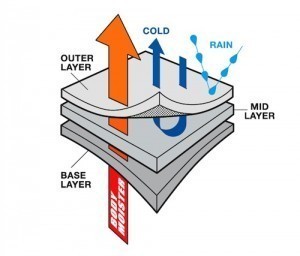The Art of Layering
For many years most sports shop in the Netherlands have sold winter sports jackets and trousers that have always been lined and insulated. Jackets and pants that of themselves were waterproof, windtight and warm. Sounds perfect of course, until you start being active, exerting yourself, your body temperature rising; then suddenly the clothing starts feeling too warm, you starting sweating too much, you’re wet and overheated. And the worst comes when you stop or pause, and you suddenly cool down, your clothes are wet and you’re wet, cold and miserable. Added to that, this heating up and cooling down just costs a lot of energy. Also, oftentimes these products are bulky, hardly packable and just not very flexible and versatile in use.
Enter the Art of layering. A better and often more flexible way to cope with the cold, tough conditions during high-intensity activities is the three-layer system. It consists of three layers of clothing that complement each other and which you can change in relation to each other depending on the circumstances and intensity of your activity.
 This is roughly how it works:
This is roughly how it works:
Layer 1 – Baselayer
The first layer is the basis. It consists of a moisture regulating layer that is worn directly on the body. The layer has the ability to transport perspiration away from your body. For this purpose different materials are used often in different blends. From pure (merino) wool clothing to completely synthetic materials such as nylon and polyester and hybrid fabrics where merino and polyester are combined. This layer is worn tightly on the skin. Because perspiration moisture goes directly through this layer, most high-end manufacturers will also pay attention to odor-fighting strategies.
The main choice you would want to make is the choice between synthetic (polyester based) fibers and natural fibers (most often wool or merino wool).
In our section on Baselayers, you can check-out the specific characteristics of wool and synthetic fibers and get a better feel for what will fit your taste and activities the best. In short:
Natural fibers (wool and especially Merino wool):
- Good insulating properties. Warm but ventilating.
- Good transport of moisture from the skin (less strong than synthetic)
- Retention is insulating value when wet
- Naturally antibacterial – so anti-odor
Synthetic fibers (polyester and polyester blends):
- Fast drying
- Low in weight
- Good moisture transports away from your body.
- Less expensive
- Less warm than wool
NEVER wear cotton!
Cotton absorbs and holds onto water, it is cold when wet, relatively heavy and there is research showing that the fabrication of cotton is more harmful to the environment than polyester which is a by-product of the oil industry.
Layer 2 – Midlayer
The second layer is an insulating layer. This layer keeps the body warm and has to pass on perspiration moisture from the baselayer to your outer layer as quickly as possible. There are various materials used in this type of clothing, such as fleece, merino wool, down or synthetic fibers. And also “brand materials” like Primaloft (used by many brands, Hydraloft (Berghaus), ThermoBall (The North Face), and so on. Often a softshell with a windproof membrane will also do the trick. Midlayers are available in many different thicknesses. If you want to be prepared for various circumstances it is smart to buy mid layers in different thicknesses. You can easily pack the thicker layer in your backpack for when circumstances are colder (or vice versa, the thin version for warmer circumstances) or even wear them together when it gets really cold. As always, to face the changing conditions in the mountains it is always wise to have different options.
Layer 3 – Outerlayer/shell
The third – outer and protective layer – is the hardshell. This layer is wind and waterproof and is the last step in transporting perspiration moisture from your skin to the air outside. Examples of waterproof and breathable substances are Gore-Tex, Triplepoint, MPC, eVent and Dermizax. The outer layer aims to protect you from the elements so that the properties of the mid-layer and base layer remain functional. Mostly these jackets won’t’ have linings or insulation of themselves and focus on the primary function of being you breathable armor against the circumstances.
For certain circumstances (when you don’t expect too much rain, you can also wear a softshell as an outer shell, which combines layers 2 and 3.
Such is the art of layering.


